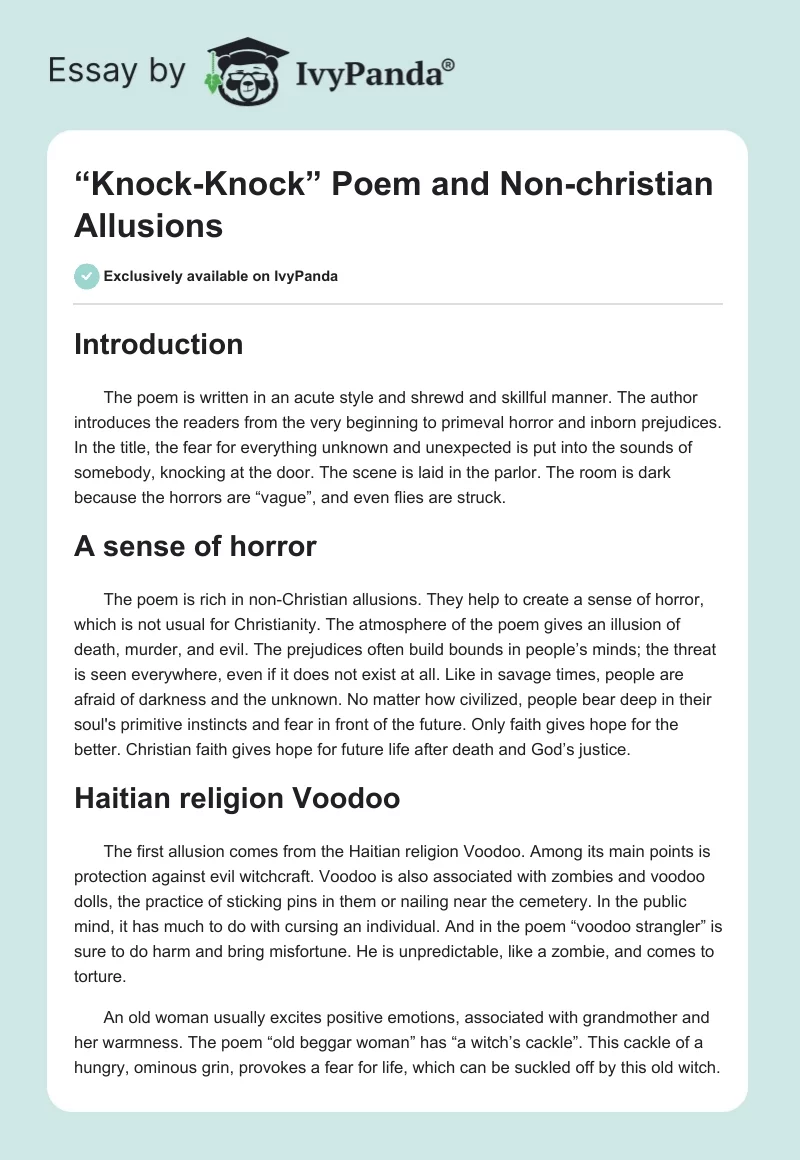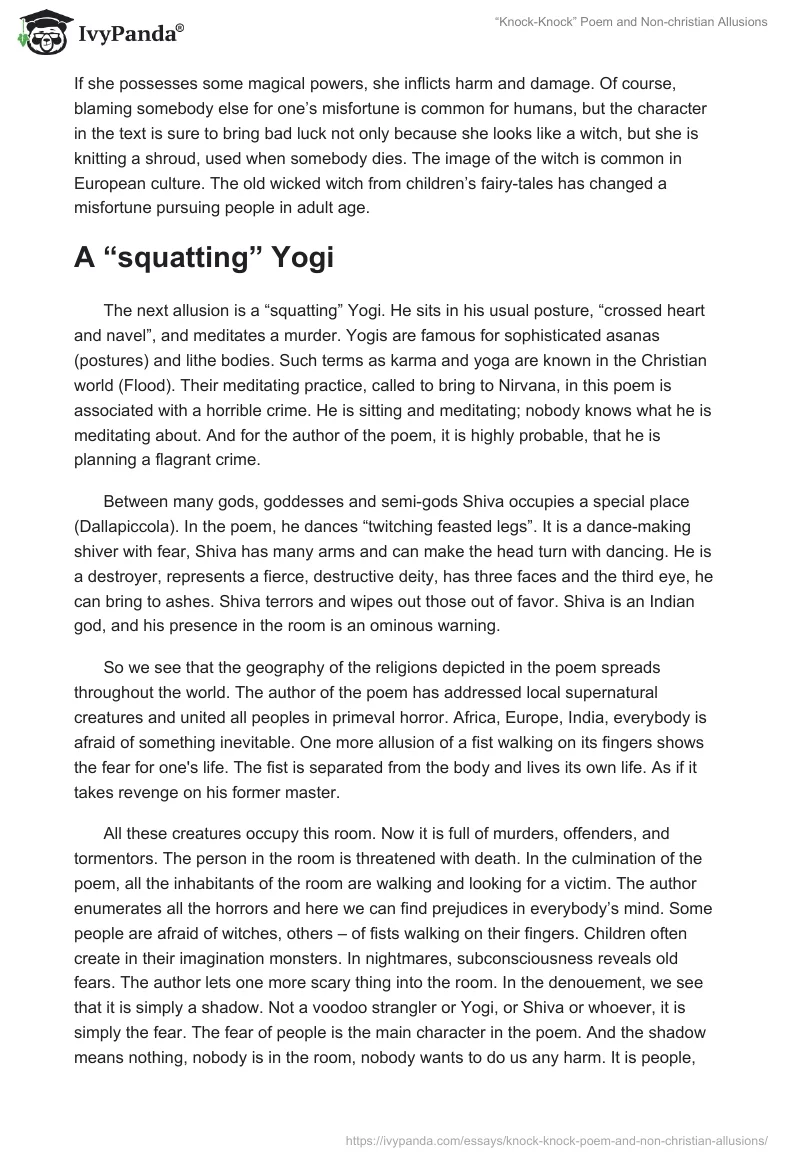Introduction
The poem is written in an acute style and shrewd and skillful manner. The author introduces the readers from the very beginning to primeval horror and inborn prejudices. In the title, the fear for everything unknown and unexpected is put into the sounds of somebody, knocking at the door. The scene is laid in the parlor. The room is dark because the horrors are “vague”, and even flies are struck.
A sense of horror
The poem is rich in non-Christian allusions. They help to create a sense of horror, which is not usual for Christianity. The atmosphere of the poem gives an illusion of death, murder, and evil. The prejudices often build bounds in people’s minds; the threat is seen everywhere, even if it does not exist at all. Like in savage times, people are afraid of darkness and the unknown. No matter how civilized, people bear deep in their soul’s primitive instincts and fear in front of the future. Only faith gives hope for the better. Christian faith gives hope for future life after death and God’s justice.
Haitian religion Voodoo
The first allusion comes from the Haitian religion Voodoo. Among its main points is protection against evil witchcraft. Voodoo is also associated with zombies and voodoo dolls, the practice of sticking pins in them or nailing near the cemetery. In the public mind, it has much to do with cursing an individual. And in the poem “voodoo strangler” is sure to do harm and bring misfortune. He is unpredictable, like a zombie, and comes to torture.
An old woman usually excites positive emotions, associated with grandmother and her warmness. The poem “old beggar woman” has “a witch’s cackle”. This cackle of a hungry, ominous grin, provokes a fear for life, which can be suckled off by this old witch. If she possesses some magical powers, she inflicts harm and damage. Of course, blaming somebody else for one’s misfortune is common for humans, but the character in the text is sure to bring bad luck not only because she looks like a witch, but she is knitting a shroud, used when somebody dies. The image of the witch is common in European culture. The old wicked witch from children’s fairy-tales has changed a misfortune pursuing people in adult age.
A “squatting” Yogi
The next allusion is a “squatting” Yogi. He sits in his usual posture, “crossed heart and navel”, and meditates a murder. Yogis are famous for sophisticated asanas (postures) and lithe bodies. Such terms as karma and yoga are known in the Christian world (Flood). Their meditating practice, called to bring to Nirvana, in this poem is associated with a horrible crime. He is sitting and meditating; nobody knows what he is meditating about. And for the author of the poem, it is highly probable, that he is planning a flagrant crime.
Between many gods, goddesses and semi-gods Shiva occupies a special place (Dallapiccola). In the poem, he dances “twitching feasted legs”. It is a dance-making shiver with fear, Shiva has many arms and can make the head turn with dancing. He is a destroyer, represents a fierce, destructive deity, has three faces and the third eye, he can bring to ashes. Shiva terrors and wipes out those out of favor. Shiva is an Indian god, and his presence in the room is an ominous warning.
So we see that the geography of the religions depicted in the poem spreads throughout the world. The author of the poem has addressed local supernatural creatures and united all peoples in primeval horror. Africa, Europe, India, everybody is afraid of something inevitable. One more allusion of a fist walking on its fingers shows the fear for one’s life. The fist is separated from the body and lives its own life. As if it takes revenge on his former master.
All these creatures occupy this room. Now it is full of murders, offenders, and tormentors. The person in the room is threatened with death. In the culmination of the poem, all the inhabitants of the room are walking and looking for a victim. The author enumerates all the horrors and here we can find prejudices in everybody’s mind. Some people are afraid of witches, others – of fists walking on their fingers. Children often create in their imagination monsters. In nightmares, subconsciousness reveals old fears. The author lets one more scary thing into the room. In the denouement, we see that it is simply a shadow. Not a voodoo strangler or Yogi, or Shiva or whoever, it is simply the fear. The fear of people is the main character in the poem. And the shadow means nothing, nobody is in the room, nobody wants to do us any harm. It is people, who create horror for themselves. People often exaggerate menaces, and fear takes molehills for mountains.
Symbols of death and horror
The author uses many symbols of death and horror. They are a shroud, murder, a witch, a fang. All these words make the poem sound even more dramatic. Everything has merged into one big lump. All the characters of the poem are doing their dark deeds: “meditating murder” or “knitting a shroud”, “walking” or “dancing”. They all move and this makes the picture even more frightening. In the vortex of creatures, it is so easy to get lost. These frightening shadows can take you alone, and there is no escape or shelter.
In the poem, there are no Christian symbols, such as a cross, or a dove, or a holy trinity. All the symbols are taken from other religions or people’s prejudices. They create an atmosphere of a horror film because the author depicted them so vividly using just several words. In this skillful manner, he asks the question “Who’s there?” never answering it. We stay in fear of fro unknown because of too many suppositions and no answer. The easiest thing to do is to assume that nobody is there, because of fear to go and seeing. Better not to know, and be a victim of one’s fear “congealed into a hunched fang”.
Conclusion
The author implies every reader in his poem; he threatens him at first, then consoles, but consoles in his special manner, when it gets even more terrible. We feel that even flies, creatures without consciousness, guided by instincts, are freeze with horror. So this poem is an excellent example of making a reader laki and be afraid at the same time. In conclusion, we may assume, that the author used non-Christian symbols to make his poem sound coherent and more vivid. We admire his skill to unite all the gods and items, filled by some kind of discomfort for usual humans, into one tapestry and create a unique picture of a room with an innocent victim and torturing creatures.
Works Cited
Dallapiccola, Anna L. Dictionary of Hindu Lore and Legend. London: Thames & Hudson, 2002.
Flood Gavin. The Ascetic Self: Subjectivity, Memory and Tradition. Cambridge University Press, 2006.


